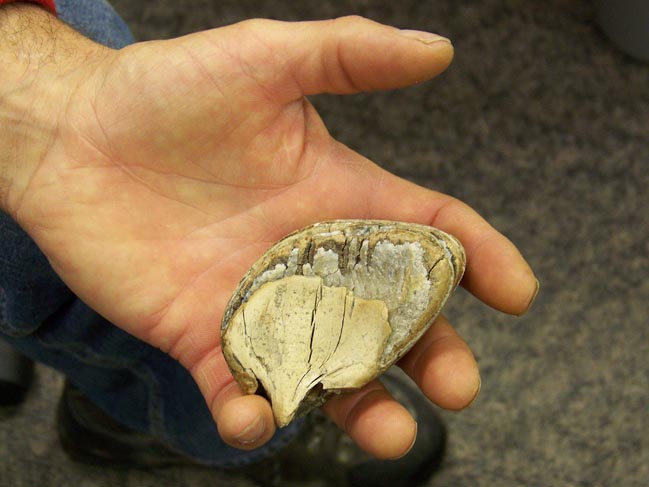A find here and a find there is one thing. Put all those finds together and a picture starts to take shape. Such has been the case with evidence of creatures that once made their home on the southern Kenai Peninsula.
The 2011 radiocarbon dating of two remains — an ankle bone and a tusk — indicated woolly mammoths roamed the area between 60,000-25,000 years ago. More pieces have surfaced and been dated since then, thanks to the effort to gather these pieces together by local author and historian Janet Klein and Soldotna geologist Dick Reger.
The most recent data comes from a woolly mammoth tooth fragment found in the Bidarka Creek area by Phil Gordon, a more complete woolly mammoth tooth found near Clam Gulch by Grace Mills and a steppe bison horn and partial skull found by A. J. Weber, also in the Diamond Creek area.
The tooth fragment found by Gordon in November 2011 was radiocarbon dated at 39,620 years, “give or take a year,” said Gordon, laughing. “What I have here is a part of our history that is difficult to even imagine.”
Gordon, who grew up on an Oregon farm and taught science, has been interested in “looking for things” for years, be it moose, sheep, tracking lynx, “all stupid stuff that are just part of looking around. … If we’re going to find some pieces of the puzzle, somebody’s got to be out there looking around.”
While roaming around the Deep Creek area after flooding hit the peninsula in 2003, Gordon found a piece of woolly mammoth tusk. In November, he was hiking with a visiting friend when he found the tooth fragment.
“I said if I was looking for a tooth, I wouldn’t be looking right at our feet, I’d be looking … and I picked it up at the very moment,” he said of looking down and finding exactly what he said wouldn’t be found right there.
That surprise and that success keep Gordon’s eyes open.
“Of course, I fully expect to find an entire, intact mammoth. It’s just a matter of time,” he said, then added that “statistically, there’s almost no chance you’ll find anything, but I’ve continued looking for something,” he said.
Eleven-year-old Grace Mills found what she thought was an interesting rock while at the family’s set-net fishing site about six miles south of Clam Gulch earlier this year. When her grandfather, Brent Johnson, saw it, he recognized it as something other than a rock.
“Luckily I had attended a presentation by (Klein and Reger) and I knew right away what it was,’ said Johnson. “I called Dick Reger and he was really excited to come down here.”
The second of the three pieces to be recently radiocarbon dated, the results indicate Grace’s woolly mammoth molar is greater than 43,500 years.
Results for the steppe bison horn and skull found by Weber have added another dimension to the peninsula history.
“We had a small, inner part of a bison horn core sent in for radiocarbon dating, but it was too porous and couldn’t be radiocarbon dated,’ said Klein. “So this is the second we’ve found and the first that’s been radiocarbon dated. That in itself is really important because it gives a date for a second species we didn’t have before. It’s an impressive find.”
Weber is, indeed, impressed.
“I wasn’t actually looking for something like this. I just turned around and there it was,” he said of what he found while hiking in the Diamond Creek area in August. “I knew it wasn’t a piece of wood or a rock. I knew it was some piece of bone.”
Having seen something similar at a shop on the Spit, Weber paid the store a visit and was told that piece had come from Interior Alaska.
“Then I got in contact with (Klein) and told her I’d like to talk to her about something I’d found. She asked if I knew what I had and I said, ‘yeah’ and told her. She said, ‘Do you know what that means?’ It was a big step for her,” said Weber of finding a steppe bison piece in such good condition. “Because of how well the skull was preserved, there’s reason to believe it didn’t move very much, which is cool. (Klein) said, ‘It’s a little bit more than cool.’”
Recalling her first sight of the horn and skull, Klein said, “My mouth dropped to the floor.”
The horn and skull measure about 19 inches in length and weigh more than nine pounds. The radiocarbon dates are the same as Grace’s molar: greater than 43,500 years.
“I was amazed when (Klein) told me the date,” said Weber. “
Klein and Reger and currently preparing the abstract of a presentation they will give at an international conference on woolly mammoths scheduled to be held in Alaska in May.
McKibben Jackinsky can be reached at mckibben.jackinsky@homernews.com.


